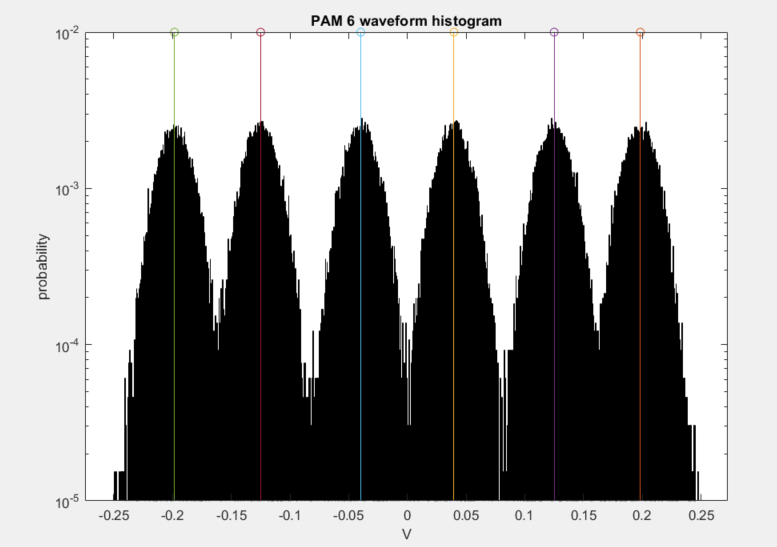Don’t know if the picture makes it through but the big hit for R_LM is the mean shift. COM reports only the “worst” eye. (‘don’t know if folks know this’) Its hard to see but the noise distribution only gets small amount wider. I tried different spreads of the symbol alphabet and the results are about the same for the “worst eye” as using as the symbol alphabet [ 1 es1*1.05 es2 es3 es4 ex5*1.05 -1]
From: Bill Kirkland <00001cd3c07be0a7-dmarc-request@xxxxxxxxxxxxxxxxx>
Sent: Thursday, March 27, 2025 10:45 AM
To: STDS-802-3-COM@xxxxxxxxxxxxxxxxx
Subject: Re: [802.3_COM] RLM
Problem I have with RLM is that there are several combinations that lead to the same RLM number.
e.g. I think [-1 -0.35 0.33333 1] (asymmetric signal set) will yield the same RLM number.
Likewise [-0.98 -0.333 0.333 1] and variations.
Granted, moving two signal points is probably a “fair” representation.
From: Richard Mellitz <000014533bad0b9c-dmarc-request@xxxxxxxxxxxxxxxxx>
Sent: Wednesday, March 26, 2025 5:52 PM
To: STDS-802-3-COM@xxxxxxxxxxxxxxxxx
Subject: [802.3_COM] RLM
Caution: This email originated outside of Semtech. |
Hi all,
I was looking at adjusting the symbol alphabet used to compute COM ISI, crosstalk, and jitter for R_LM. Presently we just use a mean shift in the eye levels by scaling As by R_LM.
The symbol alphabet used in COM PAM4 is presently [ -1 -1/3 1/3 1] or 2*(0:L-1)/(L-1)-1.
I think the symbol alphabet for pam4 would be [-1 -.35 .35 1] for R_LM= 0.95 or in general scale level 1 and L-1 by 2-R_LM for PAML.
The last time I tried this the impact on COM was small (< 0.1 dB). It could be more important for higher PAM.
This has been suggested to mebefore.
Thoughts?
… Rich
|
To unsubscribe from the STDS-802-3-COM list, click the following link: https://listserv.ieee.org/cgi-bin/wa?SUBED1=STDS-802-3-COM&A=1
To view our privacy policy, including the types of personal information we collect, process and share, and the rights and options you have in this respect, see www.semtech.com/legal.
To unsubscribe from the STDS-802-3-COM list, click the following link: https://listserv.ieee.org/cgi-bin/wa?SUBED1=STDS-802-3-COM&A=1
To unsubscribe from the STDS-802-3-COM list, click the following link: https://listserv.ieee.org/cgi-bin/wa?SUBED1=STDS-802-3-COM&A=1